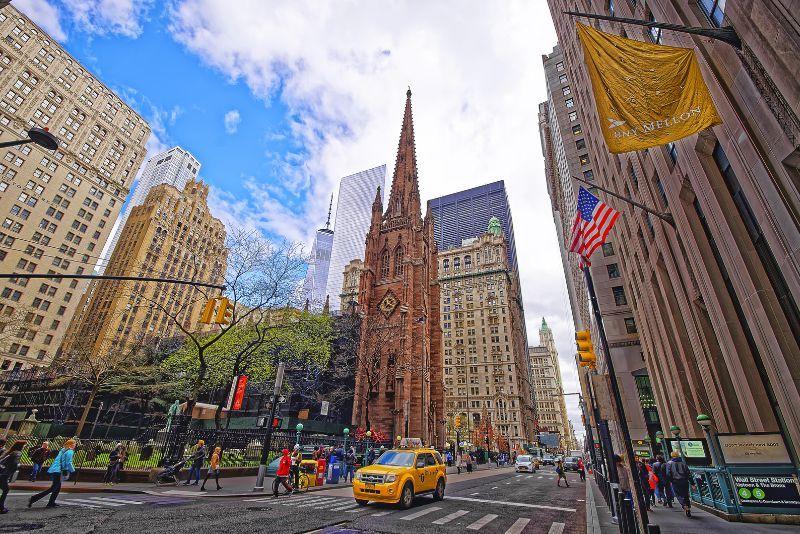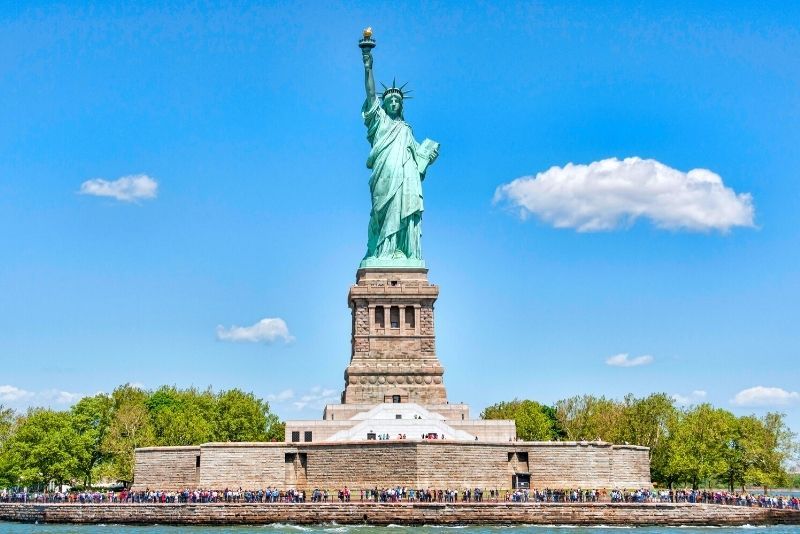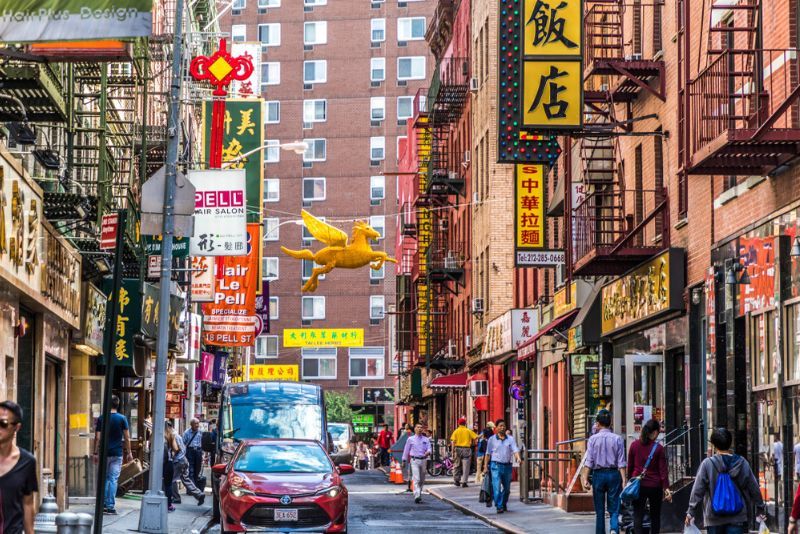Wall Street: Tours and Guided Visits
Lower Manhattan is one of the oldest regions of New York and remains one of the most prestigious. The heart of it all is Wall Street, the bustling center of the financial district. Here, America’s economy hangs in the balance, and the eyes of the world are focused on the New York Stock Exchange.
Wall Street tours take you to the famous settings for films and novels, and learn about its role in global financial crises as the money capital of America — and perhaps you’ll find the elusive “wolf” that roams Wall Street.
Lower Manhattan is one of the oldest regions of New York and remains one of the most prestigious. The heart of it all is Wall Street, the bustling center of the financial district. Here, America’s economy hangs in the balance, and the eyes of the world are focused on the New York Stock Exchange.
Wall Street tours take you to the famous settings for films and novels, and learn about its role in global financial crises as the money capital of America — and perhaps you’ll find the elusive “wolf” that roams Wall Street.

(0/24) checking Musement...
Lower Manhattan is one of the oldest regions of New York and remains one of the most prestigious. The heart of it all is Wall Street, the bustling center of the financial district. Here, America’s economy hangs in the balance, and the eyes of the world are focused on the New York Stock Exchange.
Wall Street tours take you to the famous settings for films and novels, and learn about its role in global financial crises as the money capital of America — and perhaps you’ll find the elusive “wolf” that roams Wall Street.

You will find below all you need to know about Wall Street, one of the best destinations for sightseeing tours in New York City.
How do I get to Wall Street?
Wall Street is in the heart of New York’s affluent Lower Manhattan neighborhood. It runs along eight blocks between Broadway and South Street, which borders the East River. It is only a 10-minute walk from the Brooklyn Bridge, and several transport routes pass by Wall Street.
There are three subway stations along Wall Street. Wall Street Station is on the IRT Lexington Avenue Line, Broad Street Station is on the BMT Nassau Street Line and William Street Station is on the IRT Broadway–Seventh Avenue Line. The BXM18, M15, M15-SBS, M55 and QM11 buses also stop close to Wall Street.
What are the highlights on Wall Street?
New York Stock Exchange
The beating heart of Wall Street and America’s Economy, the New York Stock Exchange sits on the corner of Wall Street and Broad Street, and is one of the most photographed landmarks in the district. Its classical revival-style façade stands out from the concrete jungle around it, and the Broad Street entrance with its marble colonnade is a sight to behold.
The NYSE has been located here for more than 150 years, and it has seen all the trials and tribulations of the financial world pass through its doors. Visitors aren’t allowed inside the premises anymore, but you can hear the legendary opening bell ring each weekday morning at 9:30 AM.
Charging Bull

It seems unlikely that a 3-ton bronze bovine sculpture would become an unmistakable symbol for New York’s financial district, but “Charging Bull” by Arturo Di Modica has become just that. The bull stands just over 3 meters tall and symbolizes aggressive financial optimism and prosperity. The artists installed it after the 1987 Wall Street crash hoping to encourage workers to keep fighting amidst their hardships.
Today, the bull stands on Bowling Green, two blocks south of Wall Street. It was moved there after initial criticism from the NYSE, but it seems right at home in the oldest public park in New York.
Trinity Church

At the northern end of Wall Street, you will be met by another juxtaposing architectural treasure. Among the concrete high-rises of Manhattan stands the Trinity Church, a gothic revival parish founded more than 300 years ago. Its notable parishioners included President George Washington and Alexander Hamilton, the latter of whom is buried inside the church.
Stroll around the churchyard to see the graves of notable New Yorkers, then head inside to admire the grand stained-glass window and newly restored pipe organ. On Sundays, you can hear the joyful chiming of the bells just before and after the 11:15 AM service.
Federal Hall
The Federal Hall is one of the most historically significant spaces in New York. George Washington’s presidential inauguration took place at Federal Hall, and the first draft of the bill of rights was penned inside its hallowed halls. Its Greek revival style exterior is hard to miss, and this grand architecture continues inside with a large domed ceiling and sparkling marble floors.
Its free exhibits are open on weekdays and include a dedication to Washington’s inauguration and one about the freedom of the press. There are also outstanding artifacts like the Bible Washington used during his swearing-in ceremony.
What are the best tours to visit Wall Street?
Wall Street tour
The eight-block stretch of Wall Street is filled with drama, intrigue and history. Take a guided tour of Wall Street to visit all the most iconic locations and hear stories of how America’s financial backbone started.
Guides will tell stories of the momentous Wall Street crash in the 80’s to the more recent GameStop saga and offer insight into how cryptocurrencies are changing the face of finance forever.
Wall Street tour with Statue of Liberty and 9/11 visit
Combine a visit to the three most remarkable locations in New York. Take a walk through Wall Street to learn about the life and times of America’s economy, then visit the somber 9/11 memorial site. Visitors can pay their respects and learn about the atrocities that occurred on one of the deadliest days in US history.
The tour concludes with a trip to Liberty Island, where visitors can enjoy priority boarding at the ferry terminal. Get off at the foot of Lady Liberty and explore Liberty Island with an audio tour and a visit to the Statue of Liberty Museum and Ellis Island Museum.

Wall Street, Little Italy, Chinatown tour
Follow a fun local guide on a tour through the prominent neighborhoods of Manhattan. Kick things off in the financial district and see the oldest part of Manhattan. Pass by Wall Street, the Charging Bull and the 9/11 memorial.
Next, you will enter the trendy Greenwich Village through 5-points, Chinatown and Little Italy. Over 150 years, migrants from all over the world have shaped these eclectic burrows by bringing their cultures, food and traditions to the shores of America.

How much do Wall Street tours cost?
Tours of Wall Street mostly range around US$30 per person. This includes an expert guide to take you around the financial district and explain all the nuances of financial trends that have shaped the current economy.
Excursions to Wall Street that include a trip to the 9/11 memorial and the Statue of Liberty are around US$60 per person, and you will receive an audio guide for Liberty Island.
A tour of the financial district, Little Italy and Chinatown costs US$50 per person, and only includes a guide.
Where do Wall Street tours start?
Tours of Wall Street usually start outside the NYSE on Broad Street or close to Federal Hall at the same intersection of Wall Street and Broad Street.
Tours that include a trip to the Statue of Liberty sometimes start at The Battery if the Liberty Island tour is first on the Itinerary. City Hall Park is also a convenient meeting point for tours that start at the 9/11 Memorial.
When is the best time to visit Wall Street?
To get the whole Wall Street experience, the best time to visit is during trading hours. The NYSE opens at 9:30 AM, and trading closes at 4 PM. After which, the streets get a little emptier, and you won’t see traders in sight.
During lunchtime, around 2 PM, you can catch traders flooding the streets in their colored vests, representing their trading firms. This will give you the true feeling of what a day in the life of a New York finance worker might look like.
Avoid taking a tour of Wall Street on weekends, as all the firms are closed, and you will only find tourists on the streets.
Travel tips
- Wear comfortable shoes. There will be a lot of walking involved on these tours.
- Try to book in advance, as many tours are only for small groups of up to 10 people.
- Keep an eye on the weather report and bring an umbrella or jacket in case of showers.
- Avoid bringing large items when going to Liberty Island. You will use lockers upon arrival, and items that do not fit in the lockers must be left outside.
